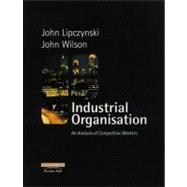| Preface | ix | ||||
| Acknowledgements | xi | ||||
| 1 Industrial organisation: an introduction | 1 | (13) | |||
|
1 | (1) | |||
|
2 | (4) | |||
|
6 | (5) | |||
|
11 | (1) | |||
|
12 | (1) | |||
|
12 | (1) | |||
|
13 | (1) | |||
| 2 Oligopoly | 14 | (35) | |||
|
14 | (5) | |||
|
19 | (7) | |||
|
26 | (9) | |||
|
35 | (8) | |||
|
43 | (1) | |||
|
43 | (1) | |||
|
43 | (5) | |||
|
48 | (1) | |||
|
48 | (1) | |||
| 3 Collusion | 49 | (54) | |||
|
49 | (1) | |||
|
50 | (5) | |||
|
55 | (7) | |||
|
62 | (11) | |||
|
73 | (4) | |||
|
77 | (6) | |||
|
83 | (15) | |||
|
98 | (1) | |||
|
98 | (1) | |||
|
99 | (3) | |||
|
102 | (1) | |||
|
102 | (1) | |||
| 4 Concentration | 103 | (35) | |||
|
103 | (1) | |||
|
104 | (4) | |||
|
108 | (7) | |||
|
115 | (1) | |||
|
116 | (17) | |||
|
133 | (1) | |||
|
133 | (1) | |||
|
134 | (3) | |||
|
137 | (1) | |||
|
137 | (1) | |||
| 5 Barriers to entry | 138 | (27) | |||
|
138 | (2) | |||
|
140 | (1) | |||
|
141 | (5) | |||
|
146 | (5) | |||
|
151 | (2) | |||
|
153 | (1) | |||
|
154 | (3) | |||
|
157 | (1) | |||
|
158 | (1) | |||
|
158 | (6) | |||
|
164 | (1) | |||
|
164 | (1) | |||
| 6 Market structure and profitability: a review of the empirical evidence | 165 | (23) | |||
|
165 | (1) | |||
|
166 | (5) | |||
|
171 | (1) | |||
|
172 | (7) | |||
|
179 | (6) | |||
|
185 | (1) | |||
|
186 | (1) | |||
|
186 | (1) | |||
|
186 | (2) | |||
| 7 Advertising | 188 | (36) | |||
|
188 | (1) | |||
|
189 | (4) | |||
|
193 | (5) | |||
|
198 | (1) | |||
|
199 | (5) | |||
|
204 | (9) | |||
|
213 | (5) | |||
|
218 | (1) | |||
|
218 | (1) | |||
|
218 | (5) | |||
|
223 | (1) | |||
|
223 | (1) | |||
| 8 Innovation | 224 | (46) | |||
|
224 | (3) | |||
|
227 | (6) | |||
|
233 | (5) | |||
|
238 | (3) | |||
|
241 | (5) | |||
|
246 | (6) | |||
|
252 | (7) | |||
|
259 | (4) | |||
|
263 | (1) | |||
|
263 | (1) | |||
|
264 | (4) | |||
|
268 | (1) | |||
|
269 | (1) | |||
| 9 Vertical relationships | 270 | (44) | |||
|
270 | (1) | |||
|
271 | (8) | |||
|
279 | (5) | |||
|
284 | (4) | |||
|
288 | (6) | |||
|
294 | (14) | |||
|
308 | (1) | |||
|
309 | (1) | |||
|
309 | (4) | |||
|
313 | (1) | |||
|
313 | (1) | |||
| 10 Diversification | 314 | (33) | |||
|
314 | (2) | |||
|
316 | (11) | |||
|
327 | (3) | |||
|
330 | (2) | |||
|
332 | (8) | |||
|
340 | (1) | |||
|
340 | (1) | |||
|
340 | (5) | |||
|
345 | (1) | |||
|
345 | (2) | |||
| 11 Competition policy | 347 | (32) | |||
|
347 | (1) | |||
|
348 | (7) | |||
|
355 | (3) | |||
|
358 | (13) | |||
|
371 | (1) | |||
|
372 | (1) | |||
|
372 | (6) | |||
|
378 | (1) | |||
|
378 | (1) | |||
| 12 Privatisation and regulation | 379 | (33) | |||
|
379 | (2) | |||
|
381 | (4) | |||
|
385 | (5) | |||
|
390 | (9) | |||
|
399 | (7) | |||
|
406 | (1) | |||
|
406 | (1) | |||
|
406 | (5) | |||
|
411 | (1) | |||
|
411 | (1) | |||
| Appendix Regression analysis | 412 | (10) | |||
| Glossary | 422 | (9) | |||
| Bibliography | 431 | (30) | |||
| Index | 461 |









